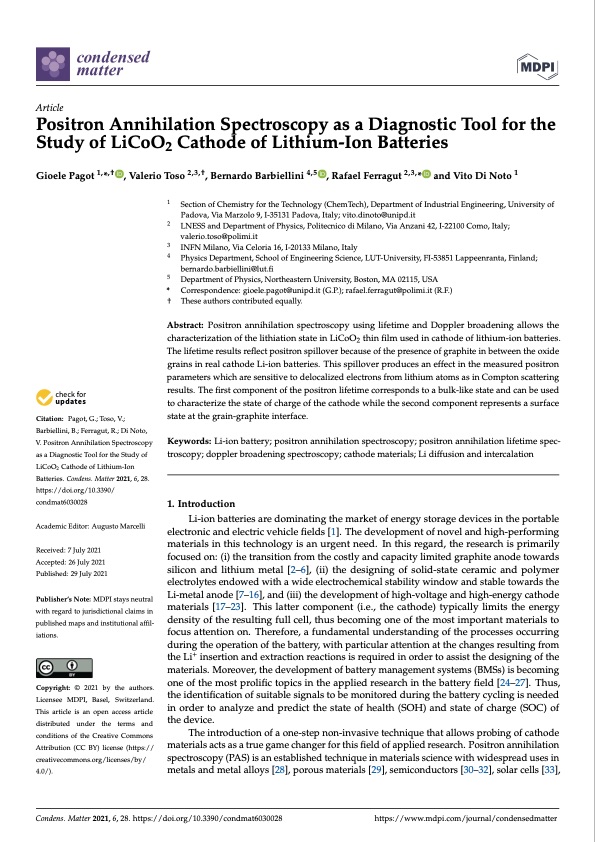
PDF Publication Title:
Text from PDF Page: 001
Article Positron Annihilation Spectroscopy as a Diagnostic Tool for the Study of LiCoO2 Cathode of Lithium-Ion Batteries Gioele Pagot 1,*,† , Valerio Toso 2,3,†, Bernardo Barbiellini 4,5 , Rafael Ferragut 2,3,* and Vito Di Noto 1 Citation: Pagot,G.;Toso,V.; Barbiellini, B.; Ferragut, R.; Di Noto, V. Positron Annihilation Spectroscopy as a Diagnostic Tool for the Study of LiCoO2 Cathode of Lithium-Ion Batteries. Condens. Matter 2021, 6, 28. https://doi.org/10.3390/ condmat6030028 Academic Editor: Augusto Marcelli Received: 7 July 2021 Accepted: 26 July 2021 Published: 29 July 2021 Publisher’s Note: MDPI stays neutral with regard to jurisdictional claims in published maps and institutional affil- iations. Copyright: © 2021 by the authors. Licensee MDPI, Basel, Switzerland. This article is an open access article distributed under the terms and conditions of the Creative Commons Attribution (CC BY) license (https:// creativecommons.org/licenses/by/ 4.0/). 1 2 3 4 5 * Correspondence: gioele.pagot@unipd.it (G.P.); rafael.ferragut@polimi.it (R.F.) † These authors contributed equally. Abstract: Positron annihilation spectroscopy using lifetime and Doppler broadening allows the characterization of the lithiation state in LiCoO2 thin film used in cathode of lithium-ion batteries. The lifetime results reflect positron spillover because of the presence of graphite in between the oxide grains in real cathode Li-ion batteries. This spillover produces an effect in the measured positron parameters which are sensitive to delocalized electrons from lithium atoms as in Compton scattering results. The first component of the positron lifetime corresponds to a bulk-like state and can be used to characterize the state of charge of the cathode while the second component represents a surface state at the grain-graphite interface. Keywords: Li-ion battery; positron annihilation spectroscopy; positron annihilation lifetime spec- troscopy; doppler broadening spectroscopy; cathode materials; Li diffusion and intercalation 1. Introduction Li-ion batteries are dominating the market of energy storage devices in the portable electronic and electric vehicle fields [1]. The development of novel and high-performing materials in this technology is an urgent need. In this regard, the research is primarily focused on: (i) the transition from the costly and capacity limited graphite anode towards silicon and lithium metal [2–6], (ii) the designing of solid-state ceramic and polymer electrolytes endowed with a wide electrochemical stability window and stable towards the Li-metal anode [7–16], and (iii) the development of high-voltage and high-energy cathode materials [17–23]. This latter component (i.e., the cathode) typically limits the energy density of the resulting full cell, thus becoming one of the most important materials to focus attention on. Therefore, a fundamental understanding of the processes occurring during the operation of the battery, with particular attention at the changes resulting from the Li+ insertion and extraction reactions is required in order to assist the designing of the materials. Moreover, the development of battery management systems (BMSs) is becoming one of the most prolific topics in the applied research in the battery field [24–27]. Thus, the identification of suitable signals to be monitored during the battery cycling is needed in order to analyze and predict the state of health (SOH) and state of charge (SOC) of the device. The introduction of a one-step non-invasive technique that allows probing of cathode materials acts as a true game changer for this field of applied research. Positron annihilation spectroscopy (PAS) is an established technique in materials science with widespread uses in metals and metal alloys [28], porous materials [29], semiconductors [30–32], solar cells [33], Section of Chemistry for the Technology (ChemTech), Department of Industrial Engineering, University of Padova, Via Marzolo 9, I-35131 Padova, Italy; vito.dinoto@unipd.it LNESS and Department of Physics, Politecnico di Milano, Via Anzani 42, I-22100 Como, Italy; valerio.toso@polimi.it INFN Milano, Via Celoria 16, I-20133 Milano, Italy Physics Department, School of Engineering Science, LUT-University, FI-53851 Lappeenranta, Finland; bernardo.barbiellini@lut.fi Department of Physics, Northeastern University, Boston, MA 02115, USA Condens. Matter 2021, 6, 28. https://doi.org/10.3390/condmat6030028 https://www.mdpi.com/journal/condensedmatterPDF Image | Positron Annihilation Spectroscopy LiCoO2 Cathode of Lithium-Ion Batteries

PDF Search Title:
Positron Annihilation Spectroscopy LiCoO2 Cathode of Lithium-Ion BatteriesOriginal File Name Searched:
condensedmatter-06-00028.pdfDIY PDF Search: Google It | Yahoo | Bing
Sulfur Deposition on Carbon Nanofibers using Supercritical CO2 Sulfur Deposition on Carbon Nanofibers using Supercritical CO2. Gamma sulfur also known as mother of pearl sulfur and nacreous sulfur... More Info
CO2 Organic Rankine Cycle Experimenter Platform The supercritical CO2 phase change system is both a heat pump and organic rankine cycle which can be used for those purposes and as a supercritical extractor for advanced subcritical and supercritical extraction technology. Uses include producing nanoparticles, precious metal CO2 extraction, lithium battery recycling, and other applications... More Info
| CONTACT TEL: 608-238-6001 Email: greg@infinityturbine.com | RSS | AMP |